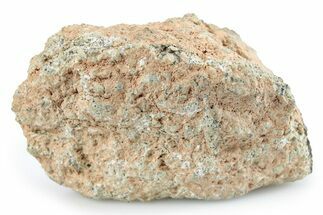This Specimen has been sold.
1.52" Rare, Fusion Crusted Martian Meteorite (38.64 g) - NWA 16289
This is an extremely rare, fusion crusted Martian shergottite meteorite, NWA 16289. It weights 38.64 grams and measures 1.52" wide. Outside of this stone, there is only recorded as being 48g of other material from this fall. Given the fusion crusting on this meteorite it was likely a fairly recent fall.
About NWA 16289
NWA 16289 is a Martian (shergottite) meteorite found in 2023 in Northwest Africa. Cut specimens feature a porphyritic texture with larger (up to 5 mm long) prismatic, polysynthetically-twinned pigeonite phenocrysts within a relatively coarse-grained groundmass consisting of stubby prismatic grains of twinned pigeonite, equant grains of olivine (partially shock-darkened), and interstitial maskelynite. Together with accessory chromite (with exsolved ilmenite), pyrrhotite, merrillite, and minor secondary calcite.
Meteoritical Bulletin: Entry for the NWA 16289 Martian Meteorite
NWA 16289 is a Martian (shergottite) meteorite found in 2023 in Northwest Africa. Cut specimens feature a porphyritic texture with larger (up to 5 mm long) prismatic, polysynthetically-twinned pigeonite phenocrysts within a relatively coarse-grained groundmass consisting of stubby prismatic grains of twinned pigeonite, equant grains of olivine (partially shock-darkened), and interstitial maskelynite. Together with accessory chromite (with exsolved ilmenite), pyrrhotite, merrillite, and minor secondary calcite.
Meteoritical Bulletin: Entry for the NWA 16289 Martian Meteorite
About Martian Meteorites (Shergottites)
Martian meteorites are rocks that formed on Mars before being ejected due to asteroid impacts, traveling through space and landing on Earth as meteorites. As you might expect, Martian meteorites are quite rare, representing less than 0.5 percent of all classified meteorites. The total mass of all known Martian meteorites is only several hundred kilograms. Superficially, Martian meteorites look very similar to igneous rocks on Earth, so nearly all have been identified from regions naturally devoid of rocks like sandy deserts (Sahara Desert and Oman) and the Antarctic ice sheets.
The achondrite meteorites are subdivided into three classes; shergottites, nakhlites, and chassignites, which together are referred to as the SNC group of meteorites. These meteorites are interpreted as Martian in origin because they have elemental and isotopic compositions similar to rocks and atmospheric gasses on Mars.
Roughly three-quarters of all Martian meteorites can be classified as shergottites. Shergottites are igneous rocks of mafic to ultramafic lithology that may have crystallized as recently as 180 million years ago. This is unusual, since most of the surface of Mars appears to be ancient, and the planet itself is rather small. Because of this, some believe that shergottites are actually much older. This "Shergottite Age Paradox" remains unsolved and is still an area of active research and debate.
Martian meteorites are rocks that formed on Mars before being ejected due to asteroid impacts, traveling through space and landing on Earth as meteorites. As you might expect, Martian meteorites are quite rare, representing less than 0.5 percent of all classified meteorites. The total mass of all known Martian meteorites is only several hundred kilograms. Superficially, Martian meteorites look very similar to igneous rocks on Earth, so nearly all have been identified from regions naturally devoid of rocks like sandy deserts (Sahara Desert and Oman) and the Antarctic ice sheets.
The achondrite meteorites are subdivided into three classes; shergottites, nakhlites, and chassignites, which together are referred to as the SNC group of meteorites. These meteorites are interpreted as Martian in origin because they have elemental and isotopic compositions similar to rocks and atmospheric gasses on Mars.
Roughly three-quarters of all Martian meteorites can be classified as shergottites. Shergottites are igneous rocks of mafic to ultramafic lithology that may have crystallized as recently as 180 million years ago. This is unusual, since most of the surface of Mars appears to be ancient, and the planet itself is rather small. Because of this, some believe that shergottites are actually much older. This "Shergottite Age Paradox" remains unsolved and is still an area of active research and debate.
TYPE
Shergottite
AGE
LOCATION
Northwest Africa
SIZE
1.52 x 1.33 x .65", Weight: 38.64 grams
CATEGORY
SUB CATEGORY
ITEM
#308457
 Reviews
Reviews

















